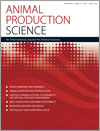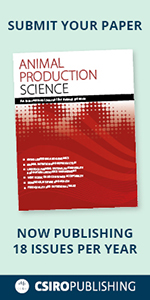
Animal Production Science
Volume 52 Number 12 2012
AN11251Foraging strategies of goats in a pasture of wheat and shrubland
Sustainabilty of shrubland is threatened by heavy and uncontrolled grazing throughout the world. The effects of genotype on foraging strategies of goats in a wheat pasture and shrublands were investigated. Grazing preferences and behaviours differed by genotypes; however, there were high individual variations within genotype and age groups. Results suggested that cereal pastures had the potential to reduce the grazing pressure of goats on shrubs in early spring.
AN12040The in vitro rumen methane output of perennial grass species and white clover varieties, and associative effects for their binary mixtures, evaluated using a batch-culture technique
White clover in grassland swards was expected to reduce methane output during rumen digestion. A simulated rumen was used to compare methane output when grass, white clover or their mixtures were digested, and surprisingly even though white clover produced less methane than grass, the mixtures produced more than expected. This outcome indicates that these comparisons need to be scaled-up and tested with cattle and sheep.
AN11352Yearly emission factors of ammonia and particulate matter from three laying-hen housing systems
From 2013, the conventional cages used for rearing laying hens will no longer comply with European rules on Animal Welfare, leading to the adoption by farmers of other rearing systems according to the Integrated Prevention Pollution Control indications. In this study, ammonia and dust emissions from a traditional housing system and from two best available techniques (BAT) solutions for layers were evaluated. The aviary system, even if a BAT solution, showed the highest ammonia and dust emissions.
AN12097Effect of dietary supplementation with Acacia karroo leaves on fatty acid profiles and consumer sensory attributes of Xhosa lop-eared goats under artificial haemonchosis
Consumption of Acacia karroo could enable reduction of gastrointestinal infections in goats thereby improving the quality of meat and fatty acids. The current study on the utilisation of Acacia karroo leaves by goats showed an improvement in fatty acid profiles of goats infected with H. contortus. Obtained information could be used in strategies for improved goat production in communal areas.
AN12171Mitochondrial treason: a driver of pH decline rate in post-mortem muscle?
The flavour, colour and texture of meat is influenced by pH decline. How and why pH decline occurs post-mortem is not fully understood. Here, I argue that mitochondria play an undiscovered role in driving pH decline in meat, thereby offering new opportunities for intervention as well as understanding.
AN12129Use of laparoscopic intrauterine insemination associated with a simplified superovulation treatment for in vivo embryo production in sheep: a preliminary report
Is it possible to improve the effectiveness of simplified procedures for superovulation and embryo recovery in sheep? Two semen doses have been compared using intrauterine insemination and a simplified superovulation treatment, as a potential mean of obtaining embryos. The response seems to depend on donor sheep age, and the use of a higher number of sperm cells per mL results in better outcomes in terms of embryos produced.
AN12126Effects of wild-type, AR1 and AR37 endophyte-infected perennial ryegrass on dairy production in Victoria, Australia
A 3-year grazing experiment compared the effects of wild-type ryegrass endophyte and two novel endophytes (AR1 and AR37), on milk production from dairy cows. Under dairy management and supplementary feeding regimes common to south-eastern Australia, the novel endophytes had no effect on the milk production compared with the wild-type endophyte, and did not cause ryegrass staggers. Pasture growth rates and incidence of redheaded and blackheaded cockchafers were not different under the three endophyte treatments.
AN12102Susceptibility of the sheep body louse [Bovicola ovis (Schrank), Phthiraptera: Trichodectidae] to temephos and concentration stability during sheep dipping with a commercial temephos product
Temephos is the most commonly applied wet dipping product used on sheep in Australia, yet there is little information about it. Here, laboratory assays that measured the susceptibilities of louse populations to temephos are described and temephos concentration in a commercial dip is monitored during on-farm dipping. With no significant cross-resistance, wool producers should feel confident that use of temephos according to label directions should be effective.
AN12104Voluntary intake of a medicated feed block by grazing sheep is increased by gastrointestinal nematode infection
Slowing development of drench resistance while providing effective worm control in sheep may be possible with self-medication. This field experiment aimed to determine if worm infection alters intake of a medicated feed block by grazing sheep and results indicate that infection leads to self-medication. This behavioural change in infected sheep may be the basis for future voluntary treatment programs.
AN12008Fenbendazole as a method for measuring supplement intake in grazing sheep
There is a need for an accurate and non-hazardous method to measure individual intake of supplements in grazing sheep over a prolonged period. The potential of fenbendazole as a marker of intake was examined. The results show that fenbendazole metabolites in plasma are dependent on dose in a range of situations and indicate that fenbendazole is a useful and accurate marker of supplement intake in grazing animals.
AN12088Effect of transportation on ostrich (Struthio camelus) weight loss and meat quality
Little is known of the effect of transport distance on the meat quality of ostriches. Ostriches travelled 60 or 600 km to quantify the effect of transport distance on their meat quality. It was shown that the longer the distance ostriches travel, the more negative the effect on the meat yield and quality.



